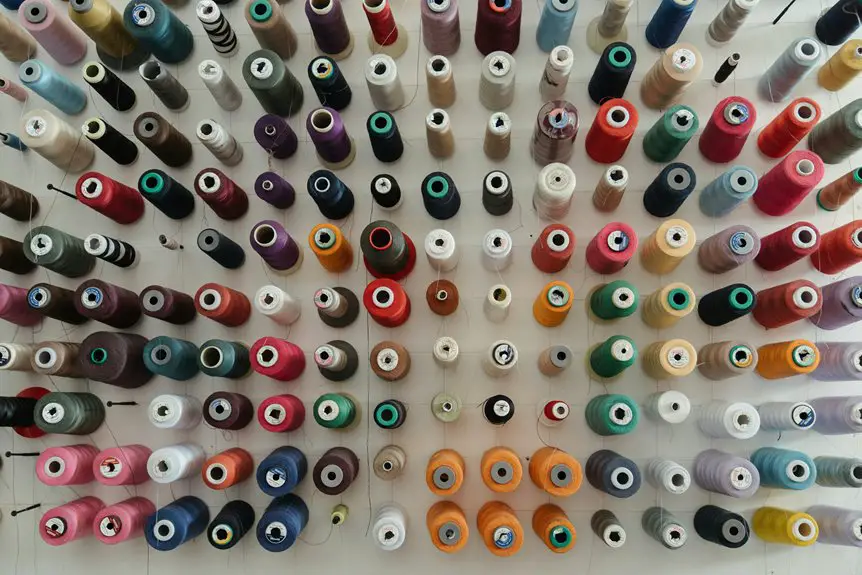You might think polyester fabrics all handle sweat the same way, but that’s not quite the case. While many associate polyester with quick-drying, moisture-wicking properties, the reality depends on several factors you might not expect. From the fabric’s weave to chemical treatments, these details can make a big difference in comfort and performance. Before you choose your next workout gear, it’s worth exploring what really sets moisture-wicking polyester apart.
Table of Contents
Key Takeaways
- Polyester is naturally hydrophobic, but not all polyester fabrics are designed to wick moisture effectively.
- Fabric construction, such as knit or mesh, greatly impacts polyester’s ability to move moisture away from the skin.
- Chemical treatments like hydrophilic finishes are often applied to polyester to enhance moisture-wicking properties.
- Polyester blends with cotton or spandex may reduce moisture-wicking efficiency compared to pure polyester.
- Always check product labels for specific moisture-wicking claims, as not all polyester garments offer this feature.
Understanding Polyester’s Hydrophobic Nature
Polyester’s hydrophobic nature means it naturally repels water rather than absorbing it. When you look at different polyester types, you’ll notice they all share this basic characteristic, which limits moisture absorption. This means moisture won’t easily soak into the fibers, helping you stay dry during light activities.
However, not all polyester fabrics handle moisture the same way. Some types may feel clammy because they trap sweat against your skin, while others are engineered to move moisture away more efficiently.
The Role of Fabric Construction in Moisture-Wicking
Although the fiber itself repels water, the way fabric is constructed plays an essential role in how effectively it manages moisture. Different fabric types and their construction affect moisture retention and drying speed. For instance, tightly woven polyester traps moisture, while knits allow better airflow, enhancing moisture-wicking. When choosing activewear, understanding these differences helps you pick fabrics that keep you dry.
| Fabric Type | Construction | Moisture Retention Level |
|---|---|---|
| Woven Polyester | Tight Weave | High |
| Knit Polyester | Looser Knit | Low |
| Mesh Polyester | Open Weave | Very Low |
| Brushed Polyester | Napped Surface | Moderate |
| Interlock Knit | Double Knit | Low |
This table highlights how fabric construction influences moisture management.
Chemical Treatments That Enhance Moisture Management
You’ll find that chemical treatments play a big role in boosting polyester’s moisture-wicking abilities.
Hydrophilic and hydrophobic finishes help manage moisture, while antimicrobial treatments keep odor in check.
It’s also important to evaluate how long these treatments last through wear and washing.
Hydrophilic and Hydrophobic Finishes
Chemical finishes play an essential role in enhancing how polyester handles moisture.
When you look at moisture-wicking polyester, it’s often treated with hydrophilic treatments that attract and pull moisture away from your skin. These finishes make the fabric absorb sweat quickly, then spread it across the surface to evaporate faster, keeping you dry.
On the other hand, hydrophobic characteristics repel water, preventing the fabric from becoming saturated. When polyester has hydrophobic finishes, it resists moisture penetration, which can be useful for outer layers but might limit breathability.
Understanding these finishes helps you choose polyester gear that suits your activity—whether you want quick sweat absorption or water resistance. Not all polyester is treated the same, so check the fabric’s finish to know how it manages moisture.
Antimicrobial Moisture Control
Besides hydrophilic and hydrophobic finishes, antimicrobial treatments add another layer of moisture control to polyester fabrics. These treatments inhibit bacterial growth, which reduces odor and improves fabric freshness by managing moisture retention effectively. When you choose polyester with antimicrobial properties, you get enhanced comfort during workouts or daily wear.
| Treatment Type | Moisture Control Effect | Additional Benefit |
|---|---|---|
| Silver-based agents | Limits moisture retention | Antimicrobial, odor control |
| Zinc pyrithione | Moderate moisture control | Antifungal properties |
| Quaternary ammonium | Reduces moisture retention | Long-lasting freshness |
| Chitosan | Enhances moisture wicking | Natural antimicrobial agent |
| Triclosan | Controls moisture retention | Effective against bacteria |
These chemical treatments help polyester stay dry and fresh longer, enhancing overall performance.
Durability of Chemical Treatments
Although moisture-wicking treatments greatly improve polyester’s performance, their effectiveness depends on how long they last through wear and washing. You might assume these chemical treatments remain permanent, but their chemical stability varies.
Over time, repeated laundering and exposure to sweat can break down the treatment’s molecules, reducing moisture management capabilities. Treatment longevity hinges on the quality of the chemicals used and the application method.
High-quality treatments with strong chemical stability maintain their moisture-wicking properties longer, saving you from early replacement or diminished comfort.
When choosing moisture-wicking polyester, consider not just initial performance but also how well the treatment holds up. Understanding durability helps you pick fabrics that stay effective, keeping you dry and comfortable through countless wears and washes.
Impact of Yarn Cross-Section and Weave on Performance
When you look closely at polyester fabrics, you’ll see that the yarn’s cross-section and the weave pattern play crucial roles in moisture-wicking performance.
The yarn shape affects how moisture moves along the fiber, while weave density controls airflow and absorption.
Here’s how these factors impact you:
- Yarn Shape: Flat or hollow yarns create channels for faster moisture transport.
- Round Yarn: Less surface area slows moisture movement.
- Tight Weave Density: Limits airflow, reducing evaporation.
- Loose Weave Density: Enhances breathability, speeding moisture drying.
Differences Between Pure Polyester and Blended Fabrics
You might notice that pure polyester feels different from blended fabrics, especially in how it handles moisture.
When polyester is mixed with other fibers, its moisture-wicking ability can change, sometimes for better or worse.
Understanding these differences helps you choose the right fabric for your needs.
Pure Polyester Characteristics
Polyester’s moisture-wicking ability depends heavily on whether it’s pure or blended. When you’re dealing with pure polyester, you’re working with 100% polyester fibers, which have distinct characteristics:
- Low moisture retention – pure polyester repels water, so sweat moves away from your skin.
- Quick drying – it dries faster than many natural fibers.
- Lightweight and durable – perfect for activewear that needs to hold up under stress.
- Limited breathability – sometimes, it can trap heat, making you feel warmer.
Understanding these traits helps you realize why pure polyester often feels slick and dries fast but mightn’t always keep you cool.
Effects of Fiber Blends
Although pure polyester offers excellent moisture-wicking, blending it with other fibers changes how the fabric performs.
When you choose a polyester blend, the fiber performance depends heavily on the blend properties. For example, mixing polyester with cotton often softens the fabric but may reduce its ability to wick moisture effectively.
Blends with spandex add stretch but can alter breathability. You’ll notice that each fiber in the blend contributes unique qualities, affecting durability, comfort, and drying time.
Impact on Moisture-Wicking
When you compare pure polyester to blended fabrics, you’ll notice a clear difference in moisture-wicking performance.
Pure polyester is engineered for low moisture retention and high fabric breathability, which helps sweat evaporate quickly. Blended fabrics, however, can alter these properties depending on the fibers combined.
Here’s what you should keep in mind:
- Pure polyester typically offers superior moisture-wicking due to its hydrophobic nature.
- Blends with natural fibers like cotton increase moisture retention, reducing drying speed.
- Adding spandex or nylon may enhance stretch but can affect breathability.
- The specific blend ratio directly influences how well the fabric moves moisture away from your skin.
Applications Where Moisture-Wicking Polyester Excels
If you spend a lot of time working out or outdoors, moisture-wicking polyester can make a big difference in your comfort.
This fabric is a go-to choice for athletic apparel because it pulls sweat away from your skin, keeping you dry and focused during intense workouts.
When you’re hiking, running, or camping, moisture-wicking outdoor gear helps regulate your body temperature, preventing chills caused by damp clothing.
You’ll find it in base layers, socks, and even hats designed for active use.
However, not all polyester offers this benefit, so look for products specifically labeled as moisture-wicking.
Frequently Asked Questions
Can Moisture-Wicking Polyester Fabrics Cause Skin Irritation?
Sensitive skin sometimes suffers from synthetic scrapes. You’ll find skin sensitivity spikes with specific fabric compositions, even in moisture-wicking polyester. Always assess your skin’s reaction to fabrics to avoid irritation and guarantee comfort during wear.
How Does Washing Affect Moisture-Wicking Polyester Longevity?
You’ll extend moisture-wicking polyester’s life by using gentle washing techniques and proper fabric care. Avoid harsh detergents and high heat, as they can damage fibers, reducing effectiveness and causing premature wear.
Are Moisture-Wicking Polyesters Environmentally Sustainable?
You should know that only about 14% of polyester gets recycled, making recycling processes essential for eco-friendliness. To be greener, you can explore sustainable alternatives like recycled polyester or natural fibers instead of virgin polyester.
Do Moisture-Wicking Polyesters Retain Odors Over Time?
You’ll find moisture-wicking polyesters sometimes retain odors over time, especially without proper fabric treatment. Treatments help reduce odor retention, so picking fabrics with these enhancements keeps your gear smelling fresher longer during workouts.
What Are Common Misconceptions About Moisture-Wicking Polyester?
You might think all moisture-wicking polyester keeps you dry, but that’s not true. Many fabrics struggle with moisture retention and lack fabric breathability, leaving you uncomfortable and sweaty despite the label’s promise.
- Tetron Fabric for Marine Applications: Durability and Use Cases - June 18, 2025
- Tetron Fabric for Outdoor Furniture: Weather Resistance and Care - June 18, 2025
- Tetron Fabric for Wall Coverings: Style and Application Tips - June 18, 2025







